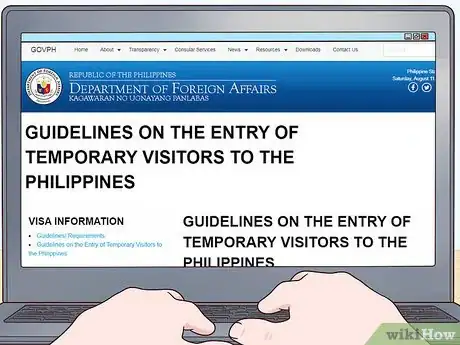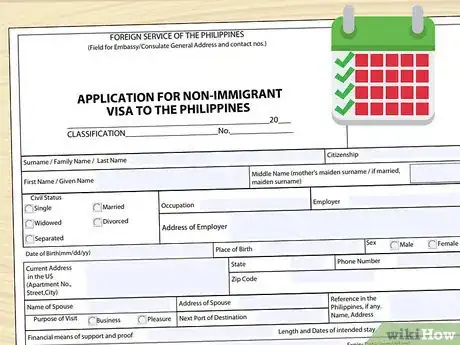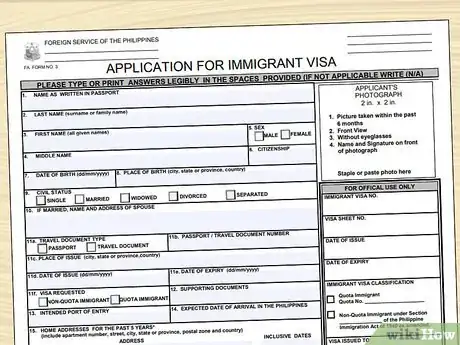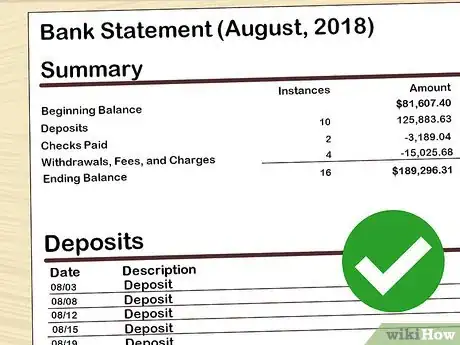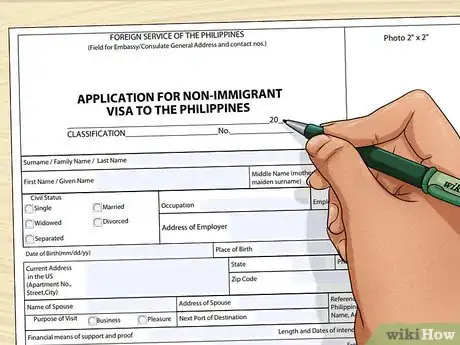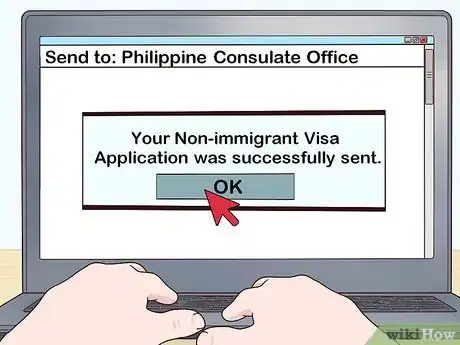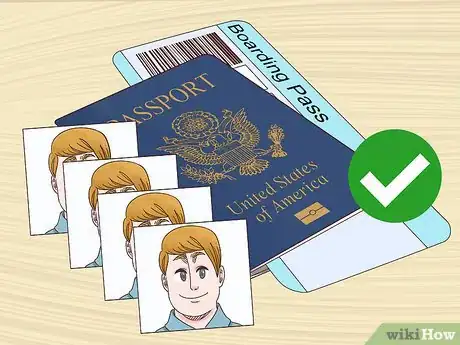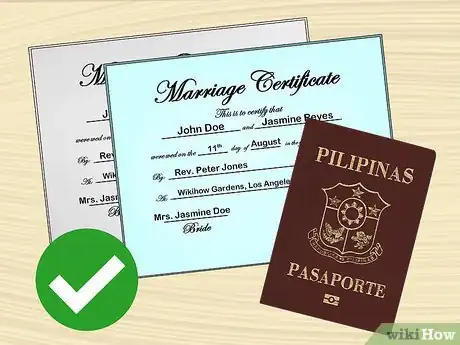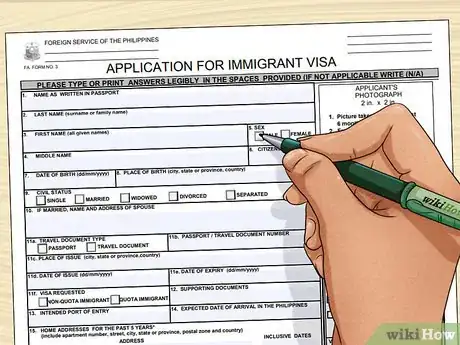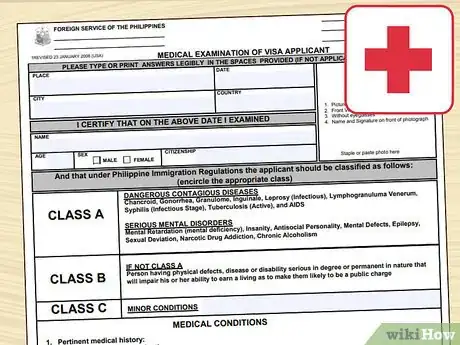This article was co-authored by Deirdre Nero. Deirdre D. Nero is an Immigration & Nationality Law Attorney and the Founder of NERO Immigration Law, P.L., based in Miami, Florida. With nearly 20 years of experience, she specializes in business-based immigration, family-based immigration, and naturalization. She earned her law degree from the University of Miami School of Law and her BA from Florida State University. In 2014, Deirdre won Business Immigration Lawyer of the Year–Florida in the Global Mobility & Immigration Awards given by Acquisition International. She’s also earned an AV Preeminent rating from Martindale-Hubbell, which annually rates lawyers on their abilities and ethics. Additionally, South Florida Legal Guide named her a Top Lawyer in South Florida several years in a row. In 2019, Deirdre was honored to receive the Outstanding Entrepreneur Award at the 2019 AXA Businesswoman of the Year Awards by the Coral Gables Chamber of Commerce and the Merrick in the Making Award by the Coral Gables Chamber of Commerce. In 2019 and 2021, Deirdre was named to Florida Trend Magazine’s Legal Elite.
This article has been viewed 20,066 times.
If you're wanting to stay in the Philippines past 30 days, you will likely need a visa. The 2 main types of visas are the non-immigrant visa, where your stay is temporary, and the immigrant visa, where your stay is meant to be permanent. Start by choosing the correct visa, then fill out the application and submit it.
Steps
Deciding What Visa You Need
-
1Check if you need a visa at all if you're only going for a short trip. If you're staying fewer than 30 days in the Philippines, you may not need a visa if your country is on good diplomatic terms with the Philippines. For instance, you don't need one if you're coming from the United States.[1]
- You can check the list at the following website to see if your country is included: https://www.dfa.gov.ph/list-of-countries-for-21-day-visa.
-
2Use the non-immigrant visa for temporary visits over 30 days. This visa is for things like travel, work, and education. If you're planning on becoming a resident, you typically don't use this visa.
- When deciding on a non-immigrant visa, choose from the following categories:
- 9(A) Temporary Visitor's Visa, for tourism and pleasure.
- 9(B) Transit, for traveling through the country.
- 9(C) Seaman, for workers entering the country on a boat.
- 9(D) Treaty Traders, for making financial trades in the Philippines.
- 9(E) Foreign Government Official.
- 9(F) Student.
- 9(G) Pre-Arranged Employees.
- Make sure to choose the right category so you get the correct visa form.
- If you're not sure which form you should use, call the Consulate office to ask.
Advertisement - When deciding on a non-immigrant visa, choose from the following categories:
-
3Pick the immigrant visa if you are the spouse or child of a citizen. This visa is specifically for use if you plan to stay in the Philippines. You must be married to a Filipino or be a child of a Filipino (and under 21).
- Basically, this visa allows you to stay in the Philippines until you can apply for permanent residency or citizenship. If you are over 21 and a child of a citizen, you will need to use a different visa or apply for citizenship.
Using a Non-Immigrant Visa
-
1Gather the documents you'll need. You will need a current passport that's good for at least 6 months beyond when you plan to leave the Philippines. You'll also need 2 passport photos, as well as a ticket that shows you are planning to leave the country when you say you are.
- You can have passport photos taken at most pharmacies and big-box stores.
-
2Provide proof of your financial status. You will need to show a picture of your last bank statement, as well as a letter from your employer stating how much you make and your current position. This proves that you have the cash to stay in the country for the time period you are requesting.
-
3Fill in the appropriate form. Keep in mind that there will be a form for each of these sub-categories, so make sure you get the correct one. On the form, you'll fill in basic biographical information, such as your name and address.
- You'll also need to include your passport information, contact info for your employer, and the dates you intend to be in the Philippines. You also must note if you've ever been convicted of a crime.
- Type this form on the computer and print it out or write on it in legible print.
-
4Pay the visa fee. If you're in a country that has an agreement with the Philippines, your fees will be cheaper. If you're in a country that doesn't have an agreement, your fees will be slightly more expensive.
- As of 2018, the fees for the temporary visitor's visa were $30.00 USD for a single-entry 3-month visa, $60.00 USD for a multiple-entry 6-month visa, and $90.00 USD for a multiple-entry, year-long visa, if your country has a visa agreement with the Philippines. If your country doesn't have an agreement, those visas are $40.00 USD, $80.00 USD, and $120.00 USD, respectively.
- For a seaman, the cost is $20.00 USD. The visa is free for government officials.
- Usually, you will need to pay by cash or money order. Make the money order out to Embassy of the Philippines in most countries or Philippine Consulate General in the United States.
-
5Walk or mail in the application to the Consulate. Some countries may require you to walk your application in to the local Consulate office. Otherwise, you can mail it into the Consulate.
- Include a self-addressed stamped envelope to have your passport returned. In the U.S., you must pay for priority or express shipping.
Gaining an Immigrant Visa
-
1Gather your basic documents. You will need a passport that's good for at least the next year. You will also need 4 passport photos, which you can get taken at most pharmacies and big-box stores.
- You will also need a certified document from the police saying you don't have a record (an original and a copy), as well as proof of your financial status, such as a pension fund, investments, bank certification, or a notarized Affidavit of Support signed by a relative in the Philippines (1 original and one copy).
-
2Provide the original and copies of documents to prove your relationship. You will need to send the original marriage certificate and a copy, as well as your spouse's passport showing their citizenship and a copy.
- In some cases, you may need to send in you and your spouse's birth certificates, along with copies. Check with your local Consulate.
-
3Fill in the visa application for immigrants. You will need to include basic biographical information like your address and passport information. You'll also need to add information on immediate relatives who are currently residing in the Philippines.
- This document will also ask you if you've been convicted of a crime, and it will require information about your medical history.
-
4Include the Medical Examination of Visa Applicant. This report will need to be filled out by your doctor. The doctor will need to fill in your medical history, as well as provide laboratory reports and a chest X-ray. Your doctor also must choose 1 of 3 classes for you.
- Class A indicates you have a dangerous infectious disease or severe mental illness. Class B indicates you have a disability or condition that would make you dependent on the state. Class C is for minor conditions.
- You will need to have a copy of your laboratory reports and a picture of your chest X-ray as a negative or on a disk when you're traveling to the Philippines.
-
5Show up for your interview in person. This visa application requires that you have an in-person interview at the Consulate. You will need to call and set up an appointment for your interview. Have all your required documents with you when you go.
-
6Pay the fee for the visa application. As of 2018, this visa cost $150.00 USD. You must pay by cash or money order. The Consulate doesn't accept credit cards or personal checks.
- Make the money order out to the Philippine Consulate General if in the United States or the Embassy of the Philippines if elsewhere.
Expert Interview
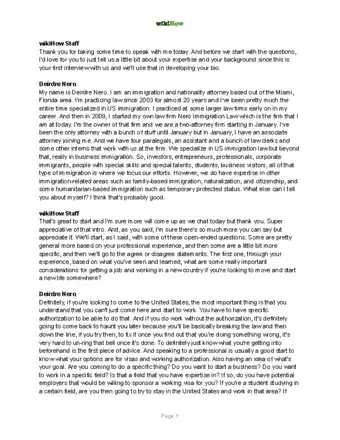
Thanks for reading our article! If you'd like to learn more about applying for a visa, check out our in-depth interview with Deirdre Nero.
